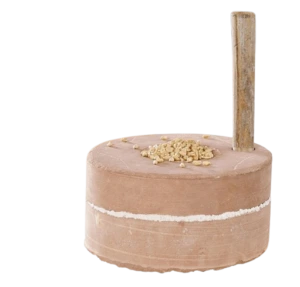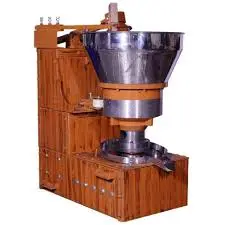Why Cold Pressed Flour (Vedic Chakki Fresh Atta) is a Game Changer?
In an era where fast-paced production dominates the food industry, traditional methods like cold pressed slow speed grinding, also known as Vedic Chakki Atta grinding, are making a remarkable comeback. These methods prioritize quality, nutrition, and authenticity over speed and quantity. Let’s explore what makes this method unique and why it is becoming the preferred choice for health-conscious individuals.
The Essence of Cold Pressed Flour (Vedic Chakki Fresh Atta)
Cold-pressed slow-speed grinding is a method rooted in traditional practices. It involves grinding grains like Wheat, Jowar, Bajra, Khapli, Multigrain and others at a slow rotational speed (Low RPM), typically using stone. Low RPM basically means per minute how many time the wheel rotates of a stone. In Cold pressed chakki or Vedic chakki, the Rpm is as low as 90-150 .Unlike modern high-speed steel rollers where the Rpm is as high as 960 to 2880, therefore the vedic chakki process ensures minimal heat generation and retains the natural nutritional properties of the grains.
Key Features of Cold Pressed Flour (Vedic Chakki Fresh Atta) :
- Slow Speed: The grinding speed is deliberately kept low to avoid frictional heat. This prevents the loss of essential nutrients such as vitamins, minerals, and fiber.
- Natural Materials: Traditional stone are used instead of metal machinery, ensuring no contamination and preserving the authenticity of the grain.
- Cold-Pressed Technique: Similar to cold-pressed oils, this method focuses on keeping the temperature low to maintain the natural flavors and nutrients of the grains.
- Fine Yet Wholesome Texture: The atta produced has a unique texture—fine enough for soft rotis yet coarse enough to retain bran and dietary fiber.
Benefits of Cold Pressed Flour (Vedic Chakki Fresh Atta) :
- Enhanced Nutrition: High-speed grinding generates heat, which can destroy vitamins like B-complex and degrade the quality of proteins and essential fatty acids. Cold-pressed grinding retains these nutrients.
- Preservation of Flavor: The traditional method enhances the natural flavor of the grains, resulting in atta that smells and tastes fresher.
- Chemical-Free: Unlike commercially produced atta, which often uses additives or preservatives, Vedic atta is free from chemicals, ensuring a pure and wholesome product.
- Supports Gut Health: The retained bran and fiber rich aid digestion and promote a healthy gut microbiome.
- Sustainability: The process uses minimal electricity and aligns with eco-friendly practices, making it a sustainable choice.
Why Choose Cold Pressed Flour (Vedic Chakki Fresh Atta?
With increasing awareness about the impact of food processing on health, many are turning to traditional methods for a healthier lifestyle. Here are some reasons why cold-pressed slow-speed grinding stands out:
- Holistic Wellness: The atta produced using this method aligns with Ayurvedic principles, supporting overall health and well-being.
- Closer to Nature: The process respects the integrity of the grain, ensuring that you consume it in its most natural and unaltered form.
Ayurvedic Perspective on Cold Pressed Flour (Vedic Chakki Fresh Atta)
As per Ayurveda, the way food is processed has a direct impact on its qualities and how it affects the body. Cold-pressed grinding offers several Ayurvedic benefits:
- Preservation of Prana (Life Energy): Grinding grains at a slow speed preserves their vital energy, or prana, which is essential for maintaining overall vitality.
- Retention of Satvik Qualities: Foods processed using this method are considered more satvik (pure and balanced), promoting mental clarity, calmness, and spiritual growth.
- Supports Digestive Agni (Fire): The retained fiber and natural nutrients enhance digestive fire, aiding better absorption and assimilation of nutrients.
- Balances Doshas: The gentle processing ensures the grains retain their natural properties, which helps balance Vata, Pitta, and Kapha doshas in the body.
- Minimized Tamas (Inertia): Unlike heavily processed foods, cold-pressed atta reduces tamasic qualities, which are linked to lethargy and sluggishness, fostering a more energetic and active lifestyle.
- Alignment with Natural Rhythms: Using traditional methods aligns with Ayurvedic principles of living in harmony with nature, ensuring better physical and mental well-being.
Modern Applications of a Traditional Method
While the concept is ancient, modern businesses are reviving it with innovative approaches. Many cold-pressed atta brands like Antram Foods are now emerging, offering products that blend tradition with convenience to buy vedic chakki fresh atta online. By choosing such products, you not only invest in your health but also contribute to preserving traditional knowledge and techniques.
Final Thoughts
Cold Pressed Flour or Slow speed Vedic Atta Chakki grinding is more than just a method—it’s a philosophy that emphasizes health, tradition, and sustainability. As consumers become more mindful about their food choices, this age-old practice holds the promise of a healthier and more authentic lifestyle. Switching to cold-pressed or vedic chakki atta is a small step towards reconnecting with the wisdom of our ancestors while nurturing our bodies with wholesome goodness.





